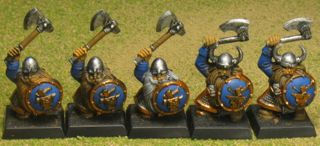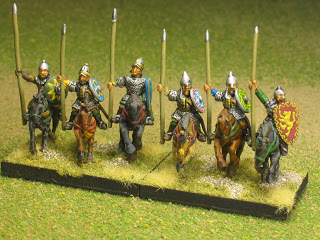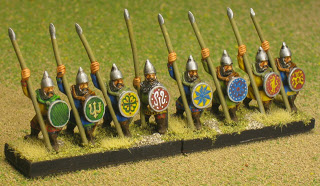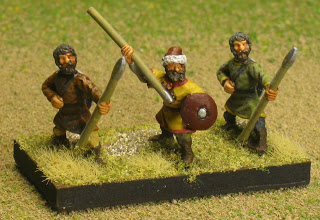Another Cold Wars has come and gone. It was a lot of fun, as usual, and it has renewed my enthusiasm for going to conventions. My friendships with friends I rarely see grow stronger, and I look forward to seeing everyone in person again soon.
I did a lot of losing this past weekend, so I’m not going to spend a lot of time dwelling on it. There are other newer, more interesting things to talk about instead.
Thursday
JM and I rode out with Larry and Rich and set up camp in a second room the hotel accidentally reserved in Larry’s name. Thanks for the mistake, no other rooms were available!
On Thursday night was Larry’s element-based theme game: Horde Wars. Armies were required to contain at least one horde, so I took Post-Mongol Samurai with four hordes. As usual, despite being a “Horde Wars” event, the metagame turned it into “Horde Killers Wars.” I usually take advantage of the opportunity to try to learn how to use the themed element type, instead of trying to learn how to kill it. This time, I’m not sure it worked, because I don’t think Hordes are as useful in large numbers as in smaller numbers.
My losses were against Ron Giampapa’s Feudal English, 2-4; Mark Bumala’s medieval army (I forget which one, but it had more Knights), 6-0; and Jason Bostwick’s Sarmations, maybe 4g-0. Basically I was crushed, and the only elements I killed in the event were Ron’s psiloi rush.
Friday
I actually got sleep Thursday night.. no wait… no, I didn’t. I had Thai iced tea and a Kahlua drink and couldn’t get to sleep at all, but JM confirmed I was snoring so I must’ve slept a little bit.
Friday morning was the first Big Event: BBDBA Doubles. JM and I took Hittite Empire (I/24a) with a Mitanni ally (I/19). This is hopefully the last time this army will be a straight spear line. Starting with Historicon, we’ll be using the DBA 2.2+ rules for BBDBA, which will convert all the Hittite 3Sp into Light Spears. This will make them weaker, but more maneuverable. I’m not sure if I’d be as willing to take Hittites to BBDBA, but I’d be more willing to play a Hittite/Mitanni matched pair.
 |
| vs. Two Davids: New Kingdom Egyptians |
In the first round, we faced Two Davids with their New Kingdom Egyptians. They placed a mandatory waterway on one edge, and marshes mucking up the deployment zone on the other edge. After protracted discussion, we chose the board edge behind the marshes, and they deployed half their army. They reserved not only their last command, but a landing party from their CinC command, giving them maximum flexibility in deploying their final forces. This won’t be legal in 2.2+.
We deployed defensively behind the marshes, with our mounted almost entirely on the right flank. This gave us a good size bad going force to fight in the marsh while our spears sat behind to prevent breakthroughs. JM refused their slowed left flank while we attacked aggressively on the right.
We won the bad going, and eventually broke one of their commands, but it wasn’t their CinC. Unfortunately, it went more slowly than we preferred, and Dave Schlanger was strictly enforcing 2.5 hour rounds this time. We couldn’t seal the deal in time, so we ended up with an unfinished game, 29-10 in our favor. This is as well as we’ve done against the Davids in person, which is good, but it is no fun to leave a game unfinished.
 |
| vs. Greek’s Greeks: Syracusan with Carthaginian ally |
In fact, we disliked it so much that we decided to do it again in the next round. We faced “Greek” Alex and Mark Pozniak playing Syracusans with a Carthaginian ally. They defended again, but placed their mandatory waterway on the flank instead. Heavy bad going bogged up the other flank, so we were destined to stick to the coast on our right flank again.
This game went very similarly to the first one, at the start. We deployed on the right flank with the intent to attack heavily with chariots and support in adjacent bad going, while refusing the left. The two games were similar enough that they get mixed up in my head. In this game, we both broke one of the enemy’s commands before time was called, and the game ended 25-22 in their favor.
 |
| vs. Hans and Franz: Alex and the Classics |
These two unfinished games pretty much spoiled the bracket and meant that someone could advance to the finals with only two wins. That turned out to be Hans and Franz, who we faced in our final round: Rich Gause and Jeff Franz playing Alexandrian Imperial with Classical Indian ally.
Oh boy, did we end up sucking this game. But at least we finished it. We placed terrain and deployed centrally and symmetrically. I deployed Mitanni on the right flank.
I really don’t like blaming the dice, and it felt like we made a lot of mistakes this game; but in some cases we really didn’t have the PIPs required to do what we knew we should have done. The first turn started with a PIP roll of 1, 1, 1, which just wasn’t enough; and it didn’t get better until it was too late. Rich was able to push his attack down the road on our left flank unopposed, and I wasn’t able to mount any coordinated attack on the right.
Jeff and Rich both played very well and definitely deserved their 100-0 victory. But that doesn’t mean I have to like it! They went on to the finals and won their final game, taking victory in BBDBA doubles. Congratulations!
In the end, we failed our goal of getting at least 100 points. Next time we’ll have to take a faster army… hopefully one that we can win with.
After BBDBA Doubles was the Pyramid Pyramid. This was a Two Davids pyramid format event using biblical era armies and the DBA 2.2+ modifications.
Dave Schlanger ran the pyramid format a bit differently than it’s done out in Ohio. Instead of carrying our losses each round, the losing players all lose 2 elements and the winners lose nothing. This provides some strategic attrition to reduce the size of the armies in play, while maintaining the same size army on both sides and rewarding winning instead of playing conservatively. It worked very well, I’d like to see this form of attrition used more widely.
I had Early Libyans, which looked quite fun in this era: Warband, Bow, Psiloi. I lost my first game to Jan Spoor’s Sea Peoples, 5-2. Playing together in the second round, Jan and I crushed Jeff Franz’s Hebrews and Larry Chaban’s New Kingdom Egyptians. In the third round, the four of us lost to Alex Bostwick, Mark Pozniak, Rich Gause, and JM Seman. The highlight of that game was my demoralized bow shooting Alex’s general (the CinC) and recoiling it to its death… but we only demoralized one of their commands before they crushed us under their unrelenting boot of progress.
Instead of playing the Midnight Madness event, which would have provided some chance of going to bed at a reasonable hour, 7 of us stayed up until 2:30am playing Arkham Horror. We had more devoured investigators than I’ve ever seen before, let alone all in the same game. In Soviet Russia, you don’t finish the game, the game finishes you. We quit while we were ahead and got some sleep… not enough, just “some.”
Stay tuned for Saturday…
































